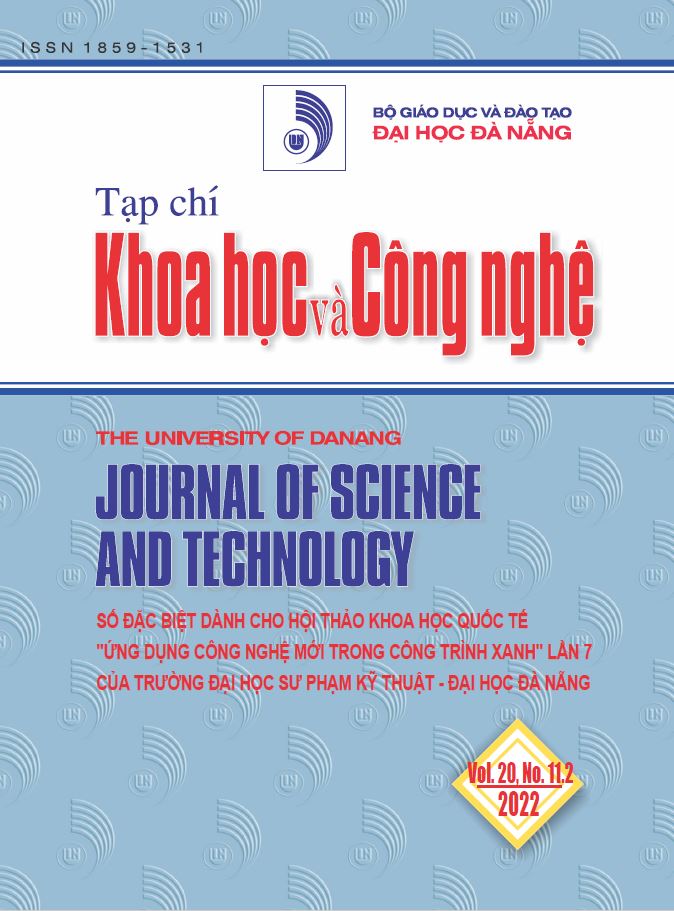Đánh giá cường độ, độ bền và vi cấu trúc của vữa cường độ cao sử dụng các hàm lượng xỉ lò cao nghiền mịn khác nhau
 Tóm tắt: 141
Tóm tắt: 141
 |
|  PDF: 95
PDF: 95 
##plugins.themes.academic_pro.article.main##
Author
-
Nguyễn Văn DũngTrường Đại học Hồng ĐứcLê Thị Thanh TâmTrường Đại học Hồng ĐứcNgô Sĩ HuyTrường Đại học Hồng Đức
Từ khóa:
Tóm tắt
Để sử dụng hiệu quả các nguồn tài nguyên cũng như tái sử dụng các phế thải rắn trong công nghiệp, nghiên cứu này sử dụng xỉ lò cao nghiền mịn (XLCNM) trong sản xuất vữa cường độ cao. Hàm lượng XLCNM được sử dụng tương ứng với 0%, 12%, 24%, 36% và 48% so với tổng hàm lượng chất kết dính. Sự thay đổi các đặc tính kỹ thuật của vữa đối với các hàm lượng XLCNM khác nhau được nghiên cứu thông qua các thí nghiệm cường độ chịu nén, cường độ chịu uốn, vận tốc truyền xung siêu âm, độ thẩm thấu ion Clo, độ truyền nhiệt, và vi cấu trúc. Kết quả nghiên cứu chỉ ra rằng, cường độ và độ bền của các mẫu vữa tăng khi sử dụng 12% hoặc 24% XLCNM, trong khi sử dụng 36% hoặc 48% XLCNM làm giảm chất lượng của vữa. Tuy nhiên, tất cả các mẫu vữa trong nghiên cứu đều có chất lượng tốt với cường độ cao, vận tốc truyền xung siêu âm qua các mẫu vữa lớn hơn 4300 m/s và khả năng chống lại sự xâm thực các ion Clo tốt.
Tài liệu tham khảo
-
[1] Opon, M. Henry, An indicator framework for quantifying the sustainability of concrete materials from the perspectives of global sustainable development, Journal of Cleaner Production. 218, 2019, 718–737. https://doi.org/10.1016/j.jclepro.2019.01.220.
[2] Chindaprasirt, C. Jaturapitakkul, W. Chalee, U. Rattanasak, Comparative study on the characteristics of fly ash and bottom ash geopolymers, Waste Management. 29, 2009, 539–543. https://doi.org/10.1016/j.wasman.2008.06.023.
[3] B. Cheah, W.K. Part, M. Ramli, The hybridizations of coal fly ash and wood ash for the fabrication of low alkalinity geopolymer load bearing block cured at ambient temperature, Construction and Building Materials. 88, 2015, 41–55. https://doi.org/10.1016/j.conbuildmat.2015.04.020.
[4] -H. Ngo, T.-P. Huynh, Effect of paste content on long-term strength and durability performance of green mortars, Journal of Science and Technology in Civil Engineering (STCE, - HUCE. 16, 2022, 113–125. https://doi.org/10.31814/stce.huce(nuce)2022-16(1)-10.
[5] TCVN 11586, Ground granulated blast-furnace slag for concrete and mortar, Vietnam Ministry of Science and Technology, 2016.
[6] -T. Liu, J.-S. Huang, Highly flowable reactive powder mortar as a repair material, Construction and Building Materials. 22, 2008, 1043–1050. https://doi.org/10.1016/j.conbuildmat.2007.03.009.
[7] -G. Lee, Y.-C. Wang, C.-T. Chiu, A preliminary study of reactive powder concrete as a new repair material, Construction and Building Materials. 21, 2007, 182–189. https://doi.org/10.1016/j.conbuildmat.2005.06.024.
[8] TCVN 3121, Mortar for masonry - Test methods, Vietnam Ministry of Science and Technology, 2003.
[9] Cwirzen, V. Penttala, C. Vornanen, Reactive powder based concretes: Mechanical properties, durability and hybrid use with OPC, Cement and Concrete Research. 38, 2008, 1217–1226. https://doi.org/10.1016/j.cemconres.2008.03.013.
[10] Peng, J. Zhang, J. Liu, J. Ke, F. Wang, Properties and microstructure of reactive powder concrete having a high content of phosphorous slag powder and silica fume, Construction and Building Materials. 101, 2015, 482–487. https://doi.org/10.1016/j.conbuildmat.2015.10.046.
[11] Yazıcı, M.Y. Yardımcı, H. Yiğiter, S. Aydın, S. Türkel, Mechanical properties of reactive powder concrete containing high volumes of ground granulated blast furnace slag, Cement and Concrete Composites. 32, 2010, 639–648. https://doi.org/10.1016/j.cemconcomp.2010.07.005.
[12] TCVN 9337, Heavy concrete - Method for electrical indication of concrete’s ability to resist chloride ion penetration, Vietnam Ministry of Science and Technology, 2012.
[13] C. Kou, C.S. Poon, Enhancing the durability properties of concrete prepared with coarse recycled aggregate, Construction and Building Materials. 35, 2012, 69–76. https://doi.org/10.1016/j.conbuildmat.2012.02.032.
[14] TCVN 4314, Mortar for masonry - Specifications, Vietnam Ministry of Science and Technology, 2003.
[15] 14TCN 80:2001, Hydraulic mortar - Specifications and test methods, Ministry of Agriculture and Rural Development, 2001.
[16] -H. Ngo, T.-P. Huynh, Effect of lubricating paste content on the engineering properties and microstructure of green mortars designed by densified mixture design algorithm, Materials Today: Proceedings. 65, 2022, 1315–1320. https://doi.org/10.1016/j.matpr.2022.04.251.
[17] A. Bogas, M.G. Gomes, A. Gomes, Compressive strength evaluation of structural lightweight concrete by non-destructive ultrasonic pulse velocity method, Ultrasonics. 53, 2013, 962–972. https://doi.org/10.1016/j.ultras.2012.12.012.
[18] Lafhaj, M. Goueygou, A. Djerbi, M. Kaczmarek, Correlation between porosity, permeability and ultrasonic parameters of mortar with variable water/cement ratio and water content, Cement and Concrete Research. 36, 2006, 625–633. https://doi.org/10.1016/j.cemconres.2005.11.009.
[19] M. Khatib, B.A. Herki, A. Elkordi, 7 - Characteristics of concrete containing EPS, in: F. Pacheco-Torgal, J. Khatib, F. Colangelo, R. Tuladhar (Eds.), Use of Recycled Plastics in Eco-Efficient Concrete, Woodhead Publishing, 2019: pp. 137–165. https://doi.org/10.1016/B978-0-08-102676-2.00007-4.
[20] Uysal, R. Demirboğa, R. Şahin, R. Gül, The effects of different cement dosages, slumps, and pumice aggregate ratios on the thermal conductivity and density of concrete, Cement and Concrete Research. 34, 2004, 845–848 https://doi.org/10.1016/j.cemconres.2003.09.018.
[21] J.C. Mendes, R.R. Barreto, A.C.B. de Paula, F.P. da F. Elói, G.J. Brigolini, R.A.F. Peixoto, On the relationship between morphology and thermal conductivity of cement-based composites, Cement and Concrete Composites. 104, 2019, 103365. https://doi.org/10.1016/j.cemconcomp.2019.103365.



